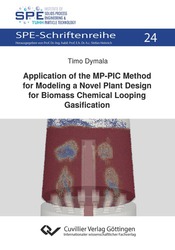| Areas | |
|---|---|
| Serie de libros (96) |
1379
|
| Nachhaltigkeit |
3
|
| Gesundheitswesen |
1
|
| Letra |
2367
|
| Ciencias Naturales |
5407
|
| Ciencias Ingeniería |
1793
|
| Ingeniería | 292 |
| Ingeniería mecánica y de proceso | 862 |
| Ingeniería eléctrica | 686 |
| Mineria y metalurgía | 30 |
| Arquitectura e ingeniería civil | 75 |
| General |
98
|
|
Leitlinien Unfallchirurgie
5. Auflage bestellen |
|
Erweiterte Suche
Application of the MP-PIC Method for Modelling a Novel Plant Design for Biomass Chemical Looping Gasification (Volumen 24) (Tienda española)
Timo Dymala (Autor)Previo
Lectura de prueba, PDF (850 KB)
Indice, PDF (33 KB)
To mitigate climate change and to reduce the emissions of greenhouse gases the interest in the utilization of renewable energies has increased drastically in the recent years. Due to the broad availability and its negative carbon emissions biomass is an attractive renewable energy resource. By applying the biomass chemical looping gasification technology the biomass can be used for the generation of electricity or the production of syngas as feedstock for synthetic fuels such as hydrogen and methanol.
To promote the progress of this technology, a novel two-stage design for the gasification reactor is proposed in this work aiming to reduce the undesired tar content in the produced syngas, while maintaining a high syngas yield. To investigate the performance of this design, a reaction model was developed using the so-called multiphase particle-in-cell (MP-PIC) method. Furthermore, optimization recommendations for biomass chemical looping processes in general were derived to adjust the syngas composition and to increase the syngas yield.
| ISBN-13 (Impresion) | 9783736978768 |
| ISBN-13 (E-Book) | 9783736968769 |
| Formato | B5 |
| Idioma | Inglés |
| Numero de paginas | 174 |
| Laminacion de la cubierta | mate |
| Edicion | 1. |
| Serie | SPE-Schriftenreihe |
| Volumen | 24 |
| Lugar de publicacion | Göttingen |
| Fecha de publicacion | 19.09.2023 |
| Clasificacion simple | Tesis doctoral |
| Area |
Allgemeine Verfahrenstechnik
|
| Palabras claves | CFD simulation, Multiphase particle-in-cell method (MP-PIC), Chemical looping gasification (CLG), Biomass gasification, Syngas, Syngas yield, Syngas composition, Fluidized bed reactor, Oxygen carrier, EMMS drag model, Two-stage fuel reactor, Reaction model, CFD-Simulation, MP-PIC Methode, Chemische Kreislaufvergasung (CLG), Biomassevergasung, Synthesegas, Synthesegasausbeute, Synthesegaszusammensetzung, Wirbelschicht, Sauerstoffträger, EMMS-Widerstandsmodell, Zweistufiger Brennstoffreaktor, Reaktionsmodell |








